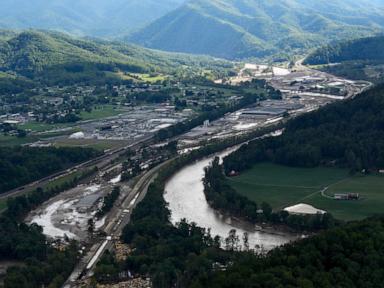
Twin babies who died alongside their mother have been named as Hurricane Helene’s youngest victims as questions are raised over unheeded warnings.
The death toll from the hurricane has now surpassed 200 as rescuers continue to search for survivors from the storm – the deadliest since Katrina in 2005 which killed more than 1,800 people – that has battered the southeast.
But in a devastating update, two newborn boys and their mother were found crushed to death after a large tree crashed through their Georgia home roof.
Among the other young victims are a seven-year-old girl and a four-year-old boy from Washington County, Georgia.
Hundreds of people are still missing and 780,000 homes were without power nearly a week after Helene made landfall as a Category 4 last week, with many left wondering whether more could have been done to sound the alarm on the huge storm before it struck.
Newborn twin brothers Khazmir Williams and Khyzier Williams, were killed along with their mother Kobe Williams, in their home in Thomson by a falling tree during Hurricane Helene on September 30
A mobile home and car along the Swannanoa River in the aftermath of catastrophic flooding caused by Tropical Storm Helene in Swannanoa, North Carolina, October 3
Debris is strewn on the lake in the aftermath of Hurricane Helene, Wednesday, October 2, in Lake Lure
TWINS
Obie Williams could hear babies crying and branches battering the windows when he answered his daughter’s daily phone call last week as Hurricane Helene tore through her rural Georgia town.
Kobe Williams, 27, and her newborn twin boys were hunkering down at their trailer home in Thomson, Georgia, and starting to fear for their safety.
She promised her father she would heed his advice to shelter in the bathroom with her month-old babies until the storm passed.
Minutes later, she was no longer answering her family’s calls.
One of her brothers dodged fallen trees and downed power lines to check on her later that day, and he could barely bear to tell his father what he saw.
A large tree had crashed through the roof, crushing Kobe and causing her to fall on top of infant sons Khyzier and Khazmir – all three were found dead.
‘I’d seen pictures when they were born and pictures every day since, but I hadn’t made it out there yet to meet them,’ Obie Williams told The Associated Press days after the storm ravaged eastern Georgia.
‘Now I’ll never get to meet my grandsons. It’s devastating.’
The babies, born August 20, are the youngest known victims of a storm that had claimed 200 lives across Florida, Georgia, Tennessee, Virginia and the Carolinas as of Thursday.
Kobe Williams was found dead with her two baby sons – who are believed to be the youngest Hurricane Helene victims
Hundreds of people are still missing and 780,000 homes were without power nearly a week after Helelne made landfall
In the elder Williams’ home city of Augusta, 30 miles east of his daughter’s home in Thomson, power lines stretched along the sidewalks, tree branches blocked the roads and utility poles lay cracked and broken.
The debris left him trapped in his neighborhood near the South Carolina border for a little over a day after the storm barreled through.
Kobe, a single mother nursing newborns, had told her family it wasn’t possible for her to evacuate with such young babies, her father said.
Many of his 14 other children are still without power in their homes across Georgia.
Some have sought refuge in Atlanta, and others have traveled to Augusta to see their father and mourn together.
They are waiting for the bodies to be released by the county coroner and for roads to be cleared before arranging a funeral.
Williams described his daughter as a lovable, social and strong young woman. She always had a smile on her face and loved to make people laugh, he said.
She was studying to be a nursing assistant but had taken time off from school to give birth to her sons.
‘That was my baby,’ her father said. ‘And everybody loved her.’
UNHEEDED WARNINGS
Before Hurricane Helene’s landfall last week, the National Weather Service began an all-out blitz to alert emergency planners, first responders and residents across the Southeast that the storm’s heavy rains and high winds could bring disaster hundreds of miles from the coast.
Warnings blared phrases such as ‘URGENT,’ ‘life threatening’ and ‘catastrophic’ describing the impending perils as far inland as the mountains of North Carolina and Tennessee.
Smartphones buzzed with repeated push alerts of flash floods and dangerous winds.
States of emergency were declared from Florida to Virginia.
And the weather service reached back to 1916 for a precedent, correctly predicting Helene would rank among the ‘most significant weather events’ the Asheville, North Carolina, area had ever seen.
But the red flags and cataclysmic forecasts weren’t enough to prevent the still-rising death toll.
The number has soared to at least 215 across six states.
At least 72 of those were in hard-hit Asheville and surrounding Buncombe County from flash floods, mudslides, falling trees, crumbled roads and other calamities.
‘Despite the dire, dire predictions, the impacts were probably even worse than we expected,’ said Steve Wilkinson, the meteorologist in charge of the National Weather Service’s regional office in Greenville-Spartanburg, South Carolina.
‘We reserve this strong language for only the worst situations,’ he said.
‘But it’s hard to go out and tell people this is going to totally change the landscape of western North Carolina.’
An aerial view, flood damage wrought by Hurricane Helene with trucks flipped over is seen along the Swannanoa River on October 3
At least 200 people were killed in six states in the wake of the powerful hurricane which made landfall as a Category 4
For many, evacuating became impossible as fallen trees and surging floodwaters made roads and bridges impassable
As the region begins its long road to recovery, a task complicated by cut-off communities, a lack of running water and still-spotty cellphone service, the growing number of casualties has prompted soul-searching among devastated homeowners and officials alike.
They wonder whether more could have been done to sound the alarms and respond in a mountainous region that’s not often in the path of hurricanes.
‘It sounds stupid to say this, but I didn’t realize it would be like bombs going off,’ Brenton Murrell said after surveying his Asheville neighborhood strewn with mud and debris, military Osprey aircraft whirring overhead.
‘It’s like a war zone.’
Like many residents, Murrell had never experienced the effects of a hurricane and felt detached from the danger despite receiving numerous warnings of ‘extreme risk of loss of life and property.’
Murrell said those words never really scared him, in part because his neighbors had been talking for days about the last big flood two decades ago and offered mostly reassuring words that ‘if you’re not in a low-lying area, you’ll be fine.’
‘There was some sort of disconnect,’ said Murrell, who now regrets riding out the storm at home with his wife, two children and dog, even though they are all safe.
‘It’s human nature to not truly comprehend something until you’ve felt it yourself.’
Many residents said they had not grasped the magnitude of the storm until it was too late.
For some, evacuating became impossible as fallen trees and surging floodwaters made roads and bridges impassable.
The cascade of emergencies caught seemingly everyone off guard.
Sara Lavery, of Canton, said she received multiple alerts last Thursday before the worst of the storm had hit and was alarmed at how quickly ‘flood watches’ on her phone progressed to ‘flood warnings.’
A washed out road is seen in Black Mountain, North Carolina, on October 3, after the passage of Hurricane Helene
A flood damaged pottery tool business in the aftermath of Hurricane Helene on October 3, in Bat Cave, North Carolina
In an aerial view, flood damage, including mangled railroad tracks, wrought by Hurricane Helene is seen along the French Broad River on October 3, in Marshall, North Carolina
Then she looked out at the Pigeon River near her home and got really scared.
‘We saw a tree the size of telephone pole, a kitchen sink, a bedroom dresser,’ she said. ‘It was terrifying.’
Still, she and her fiance decided to stay, partly because their home was on high ground, partly to leave the roads empty for others and help out endangered residents in lower areas.
‘Some people don’t have a place to go, some don’t have a four-wheel vehicle to get out,’ Lavery said.
‘People always say, `Why didn’t you evacuate?’ Not everyone can.’
‘We never thought this would happen,’ she said. ‘Western North Carolina is the mountains.’
As the storm swept through, Mia Taylor, of nearby Hendersonville, said she received alerts on her phone about the threat of floods ‘but some of us were kind of just like, `Oh, it’s not that serious.’
She tried to drive to a nearby town to shelter with her children but found ‘every which way was blocked off.’
She ended up turning around only for her car to shut off in the storm.
‘You didn’t think that it was going to be this bad,’ she said.
Lillian Govus, a Buncombe County spokesperson, said that has been a familiar refrain since the storm because no one alive in the area had seen anything approaching Helene’s destruction.
She described the storm’s pre-dawn arrival last Friday as ‘insidious,’ noting some residents were in bed and may not have heard the emergency alerts.
‘Folks were trying to evacuate, but there was nowhere to go,’ she said. ‘If there’s a landslide, it doesn’t matter how high you go.’
Wilkinson, the meteorologist, said forecasters knew many days before the storm that Helene would be catastrophic for western North Carolina and began notifying the emergency management community in briefings and presentations, focusing primarily on flooding and secondarily on wind.
Surrounding mountain towns like Asheville, a city of some 95,000, were of particular concern because the communities were built in valleys.
An AP analysis of social media postings and cellphone alerts found more than a dozen were sent by Buncombe County and the National Weather Service on Wednesday and Thursday alone.
Debris lies on the ground in the River Arts District of Asheville, after a flash flood triggered by Hurricane Helene, in Asheville, North Carolina, October 3
A damaged car sits under a destroyed shed after flooding caused by hurricane Helene in Swannanoa, North Carolina, on October 3
And the language used to convey the threat from Helene – ‘extremely rare event,’ ‘prepare for a life-threatening storm,’ ‘Act Now!’ – became increasingly dire as authorities urged people to seek higher ground and evacuate in some cases.
The most alarming ones said the destruction could be the worst in a century, referencing the ‘Great Flood of 1916’ in which 80 people were killed.
In one of its repeated postings on the social platform X, Wilkinson’s staff pleaded with residents to take its warnings ‘very seriously’ and have multiple means of receiving alerts.
‘We made an attempt based on previous events, to hit our warnings well ahead of time,’ Wilkinson told the AP, ‘so the alerts went out before the high wind hit. They kind of kept coming.’
The weather service’s rainfall and wind speed predictions largely held up, Wilkinson said, with some areas receiving more than 0.3 meters of rain.
Mount Mitchell State Park recorded wind gusts at 106 mph.
The French Broad River Basin saw rivers topping their highest-ever crests by several feet, the weather service reported, adding Helene brought ‘likely the most severe flooding in recorded history across Buncombe County.’
‘The last time a storm like this hit was in the Book of Genesis when Noah had to build an ark,’ said Zeb Smathers, the mayor of Canton, North Carolina.
Wilkinson said it might be impossible to know the number of people who didn’t heed the warnings or didn’t get them.
Cellphone service is sometimes spotty in the mountainous region and may have gotten worse as the storm rolled in.
‘I honestly believe we did everything we could have done,’ he said.
‘It’s sad that we couldn’t do more, but we’re trying to recognize that what we did made some difference.’
In the aftermath of the storm, Wilkinson’s office posted an emotional letter on X thanking first responders and calling Helene ‘the worst event in our office’s history.’
‘As meteorologists we always want to get the forecast right,’ it said. ‘This is one we wanted to get wrong.’
SEARCH FOR VICTIMS OF HURRICANE HELENE DRAGS INTO SECOND WEEK
The search for victims of Hurricane Helene dragged into its second week on Friday, as exhausted rescue crews and volunteers continued to work long days – navigating past washed out roads, downed power lines and mudslides – to reach the isolated and the missing.
‘We know these are hard times, but please know we’re coming,’ Sheriff Quentin Miller of Buncombe County, North Carolina, said at a Thursday evening press briefing.
‘We’re coming to get you. We’re coming to pick up our people.’
With at least 215 killed, Helene is already the deadliest hurricane to hit the mainland US since Katrina in 2005, and dozens or possibly hundreds of people are still unaccounted for.
Roughly half the victims were in North Carolina, while dozens more were killed in South Carolina and Georgia.
In Buncombe County alone, 72 people had been confirmed dead as of Thursday evening, Mr Miller said.
Buncombe includes the tourist hub of Asheville, the region’s most populous city.
Still, the sheriff holds out hope that many of the missing are alive.
Workers help clear mud from an auto mechanic shop that was flooded by Hurricane Helene, in Canton, North Carolina, October 3
An aerial view of vehicle bypassing a stretch of roadway washed away by flooding wrought by Hurricane Helene on October 3, in Black Mountain, North Carolina
Cars are caked in mud on a street washed away by flooding from Hurricane Helene in Swannanoa, North Carolina, on October 3
‘Your safety and well-being are our highest priority. And we will not rest until you are secure and that you are being cared for,’ he reassured.
Now more than a week since the storm roared onto Florida’s Gulf Coast, lack of phone service and electricity continues to hinder efforts to contact the missing.
That means search crews must trudge through the mountains to learn whether residents are safe.
Along the Cane River in western North Carolina’s Blue Ridge Mountains, the Pensacola Volunteer Fire Department had to cut their way through trees at the top of a valley on Thursday, nearly a week after a wall of water swept through.
Pensacola, which sits a few miles from Mount Mitchell, the highest point east of the Mississippi River, lost an untold number of people, said Mark Harrison, chief medical officer for the department.
‘We’re starting to do recovery,’ he said. ‘We’ve got the most critical people out.’
Near the Tennessee state line, crews were finally starting to reach side roads after clearing the main roads, but that brought a new set of challenges.
The smaller roads wind through switchbacks and cross small bridges that can be tricky to navigate even in the best weather.
‘Everything is fine and then they come around a bend and the road is gone and it’s one big gully or the bridge is gone,’ said Charlie Wallin, a Watauga County commissioner.
‘We can only get so far.’
Community volunteer looks over a damaged bridge in Black Mountain, North Carolina, on October 3
A damaged home is seen in Black Mountain, North Carolina, on October 3
Every day there are new requests to check on someone who has not been heard from yet, Mr Wallin said. When the search will end is hard to tell.
‘You hope you’re getting closer, but it’s still hard to know,’ he said.
Electricity is being slowly restored, and the number of homes and businesses without power dipped below one million on Thursday for the first time since last weekend, according to poweroutage.us.
Most of the outages are in the Carolinas and Georgia, where Helene struck after coming into Florida on September 26 as a Category 4 hurricane.
President Joe Biden flew over the devastation in North and South Carolina on Wednesday.
The administration announced a federal commitment to foot the bill for debris removal and emergency protective measures for six months in North Carolina and three months in Georgia.
The money will address the impacts of landslides and flooding and cover costs of first responders, search and rescue teams, shelters and mass feeding.






